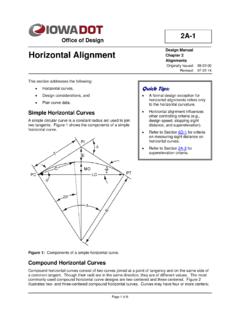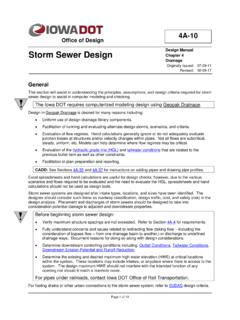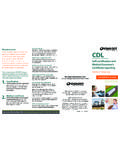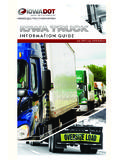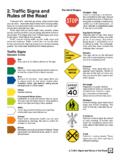Transcription of Superelevation - Iowa Department of Transportation
1 Page 1 of 8 Superelevation is the banking of a roadway along a horizontal curve so motorists can safely and comfortably maneuver the curve at reasonable speeds. A steeper Superelevation rate is required as speeds increase or horizontal curves become tighter. Definitions Side Friction - the friction force between a vehicle s tires and the pavement which prevents the vehicle from sliding off the roadway. Axis of Rotation - the point on the cross section about which the roadway is rotated to attain the desired Superelevation . Superelevation Rate (e) - the cross slope of the pavement at full Superelevation . Superelevation Runoff Length (L) - the length required to change the cross slope from 0% to the full Superelevation rate. Tangent Runout Length (x) - the length required to change the cross slope from 0% to the normal cross slope.
2 Relative Gradient (G) - the slope of the edge of pavement relative to the axis of rotation. Width (w) - the distance from the axis of rotation to the outside edge of traveled way. Figure 1 shows these definitions graphically. Superelevation 2A-2 Design Manual Chapter 2 Alignments Originally Issued: 12-31-97 Revised: 06-25-19 Design Bureau Quick Tips: The State s maximum Superelevation rate is 8% The Superelevation rate for new or reconstructed roadways should be limited to 6% for roadways with a design speed greater than 45 mph to limit cross-slope shoulder break on the high side of superelevated curves to 8% or less. Superelevation Distribution Method 2 is preferred for roadways with a design speed of 45 mph or less, but may be optional for urban roadways. Design exceptions are required for Superelevation rates that are less than the values shown in the tables in Section 2A-3.
3 Refer to the tables in Section 2A-3 for values Superelevation rates, runoff lengths, and runout lengths. Chapter 2 Alignments Section 2A-2 Superelevation Page 2 of 8 Figure 1: Graphical definitions of Superelevation terms for a two lane roadway. Superelevation Rate (e) In iowa the Superelevation rate is limited to a maximum of 8%. This reduces the risk of slow moving vehicles sliding down a superelevated roadway during winter conditions. For new construction, the Superelevation rate is limited to 6%. This allows the shoulders to slope away from the driving lanes without exceeding AASHTO s 8 percent maximum value for crossover breaks. The Superelevation rate for new urban facilities is usually limited to 4% due to the frequency of cross streets, driveways, and entrances adjoining the curve, as well as the possibility of vehicles stopping on the curve at signalized intersections.
4 Refer to Section 1C-1 for maximum Superelevation rates for 3R projects and new construction or reconstruction projects. Superelevation and Side Friction Factor Superelevation rate and side friction demand, also referred to as the side friction factor, establish radii for horizontal curves. Side friction factor represents the friction between the tires and pavement surface. This friction results in a lateral acceleration that acts upon a vehicle, and which occupants within the vehicle can feel. Like Superelevation , side friction factor is limited for design speeds. Maximum Side Friction Factors (fmax) When establishing the maximum side friction factor to use for horizontal curve design, the vehicle s need for side friction, as well as driver comfort, must be taken into account.
5 Side Friction (vehicle s need) A vehicle will begin to skid when the side friction demand equals or exceeds the maximum amount of friction that can be developed between the tires and the pavement. This maximum friction, with a factor of safety to account for variations in the speed, tire conditions, and pavement conditions, is the maximum design friction factor based upon vehicle need. Side Friction (driver comfort) Through a horizontal curve, drivers can experience a feeling of being pushed outward. If this feeling becomes uncomfortable, the driver will compensate by flattening out their path or braking, or both, to reduce lateral acceleration to an acceptable level. Often the driver s comfort determines Superelevation requirements, not the vehicle and roadway characteristics.
6 On low speed roadways, drivers will accept more lateral acceleration, thus permitting a larger side friction factor. As speeds increase, drivers become less tolerant of lateral acceleration, requiring a reduction in side friction factor. Chapter 2 Alignments Section 2A-2 Superelevation Page 3 of 8 Based upon research of the above factors, AASHTO s A Policy on Geometric Design of Highways and Streets lists maximum side friction factors for use in design of horizontal curves. These are summarized in Table 1 below. Table 1: Maximum side friction factors (fmax). Design Speed (mph) fmax Design Speed (mph) fmax 15 50 20 55 25 60 30 65 35 70 40 75 45 80 Source: AASHTO Greenbook 2011 Table 3-7. Curves should not be designed with side friction factors greater than the values shown in Table 1.
7 Distribution of Superelevation (e) and Side Friction (f) Chapter 3 of AASHTO s A Policy on Geometric Design of Highways and Streets discusses five methods of controlling lateral acceleration on curves using e, f, or both. iowa DOT uses distribution Method 2 and Method 5 depending upon the type of roadway. Low Speed Roadways Method 2 is commonly used for low speed roadways. With Method 2, side friction is primarily used to control lateral acceleration, and Superelevation is added to radii after the maximum side friction factor has been used. Superelevation is not needed for radii that require less than the maximum friction factors shown in Table 1. Distribution Method 2 increases the lateral acceleration, creating some additional discomfort to the driver for some curves.
8 Urban Roadways Drivers are willing to accept more discomfort on roadways in urban areas, due to the anticipation of more critical conditions. In addition, several factors make it difficult, if not impossible, to apply Superelevation to urban roadways: Frequency of cross streets and driveways. Vehicles stopping on curves at signalized intersections. Meeting the grade of adjacent properties. Surface drainage. Pedestrian ramps. Wider pavement area. Ramps Method 2 Superelevation distribution is also well suited for curves on ramps near at-grade terminals. Curves near at-grade terminals are usually short and drivers are traveling at reduced speeds. The relationship between Superelevation rate and minimum radius for Method 2 distribution can be expressed as follows: )+ (15V=R2maxf where: V = design speed, mph.
9 E = Superelevation rate, %. fmax = maximum friction factor for the design speed. Chapter 2 Alignments Section 2A-2 Superelevation Page 4 of 8 R = Radius of the curve, feet. Table 10 of Section 2A-3 provides minimum turning radii for various Superelevation rates and design speeds, based upon Method 2 distribution. High Speed Roadways Method 5 is used for high speed roadways. With Method 5, side friction and Superelevation are both applied using a curvilinear relationship with the inverse of the radius. At higher speeds, drivers are less comfortable with lateral acceleration through curves. Method 5, works well for determining the distribution of Superelevation and side friction for high speed roadways, because Superelevation is progressively added as speed increases. Superelevation tables for high speed roadways are included in Section 2A-3.
10 The Superelevation rate for Method 5 distribution can also be calculated manually using the equations provided in AASHTO s A Policy on Geometric Design of Highways and Streets. An Excel file has been created using these formulas and is provided at the link below. Superelevation Spreadsheet Note: When calculating Superelevation rates manually, round values of e up to the nearest 2/10ths of a percent for new construction. AAHSTO notes precision greater than 2/10ths of a percent is not necessary. Method 5 Superelevation distribution should be used for curves on ramps near free-flow terminals and curves on directional and semi- directional ramps. Axis of Rotation The axis of rotation is the point on the cross section about which the roadway is rotated to attain the desired Superelevation .
